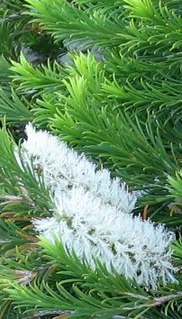
Melaleuca armillaris, commonly known as bracelet honey myrtle, is a plant in the myrtle family, Myrtaceae, and is native to South Australia, Victoria and Tasmania in south-eastern Australia. It is a hardy, commonly grown species, often used as a fast-growing screen plant, but it also has the potential to become a weed. It has become naturalised in Western Australia and parts of Victoria. In its natural state, it grows on coastal cliffs and along estuaries.

Melaleuca linariifolia is a plant in the myrtle family Myrtaceae, and is endemic to eastern Australia. It is commonly known as snow-in-summer, narrow-leaved paperbark, flax-leaved paperbark and in the language of the Gadigal people as budjur. A hardy plant, it flowers prolifically in late spring or summer, making it a popular garden shrub or small tree in temperate places. Melaleuca trichostachya is a similar species but its leaves are arranged differently and the fruits have projecting valves.

Calothamnus quadrifidus, commonly known as one-sided bottlebrush, is a plant in the myrtle family, Myrtaceae and is endemic to the south-west of Western Australia. The common name alludes to the arrangement of the flowers in the inflorescence which line up on one side of the stem. It is a shrub with grey-green, pine-like foliage covered with soft hairs and red, four-part flowers in spring. Widely cultivated because of its attractive foliage, colourful, unusual and prolific flowers, it grows in a variety of habitats and soils. In 2010, Alex George published a review of the species based on recent research and described a number of new subspecies.

Melaleuca lanceolata commonly known as black paperbark, moonah, Rottnest Island teatree and western black tea tree is a plant in the myrtle family, Myrtaceae and is native to Australia where it occurs in Western Australia, South Australia, Victoria, New South Wales and Queensland. It is a densely foliaged tree with rough bark, which flowers prolifically in summer.

Melaleuca viminea, commonly known as mohan is a plant in the myrtle family Myrtaceae and is endemic to the south-west of Western Australia. It is variable in size and form from a densely branched, small shrub to a small tree. It has become naturalised locally in southern Victoria.

Melaleuca fulgens, commonly known as the scarlet honey myrtle, is a plant in the myrtle family Myrtaceae, and is endemic to Western Australia, South Australia and the Northern Territory. It is notable for its showy orange, red or purple flowers, unusual foliage and fruit, and is a popular garden plant. It is a member of Melaleuca, a large and diverse genus whose members range from large trees such as M. quinquenervia, to small shrubs.

Melaleuca squarrosa, commonly known as scented paperbark, is a plant in the myrtle family, Myrtaceae and is endemic to south eastern parts of Australia, especially Tasmania. It is an attractive shrub with dense foliage and arching branches and it flowers profusely in spring or early summer, bearing spikes of perfumed yellow to white flowers.

Melaleuca linearis, commonly known as narrow-leaved bottlebrush, is a plant in the myrtle family, Myrtaceae and is endemic to New South Wales and Queensland in Australia. It is a medium-sized shrub with narrow leaves with a rigid point, and red flower spikes in late spring or early summer.

Melaleuca williamsii is a plant in the myrtle family, Myrtaceae and is endemic to an area between north-eastern New South Wales and south eastern Queensland in Australia. It is a distinctive shrub with stiff branches, silvery new growth, prickly leaves and spikes of purple flowers in late spring. It is classified as a vulnerable species under the Australian Government Endangered Species Protection Act.
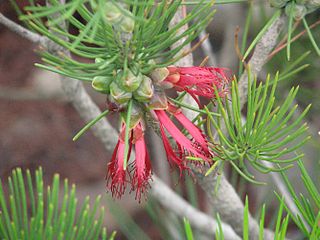
Calothamnus graniticus, commonly known as granite claw flower, is a plant in the myrtle family, Myrtaceae and is endemic to the south-west of Western Australia. There are two subspecies, both of which have been classified as "near threatened". It is an erect, rounded shrub with pine-like, dark, grey-green foliage and usually bright red flowers. Calothamnus graniticus subsp. graniticus occurs in the Leeuwin-Naturaliste National Park and is the floral emblem of the nearby city of Busselton.
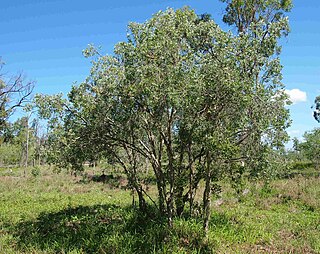
Melaleuca nervosa, commonly known as fibrebark, is a shrub or tree in the myrtle family Myrtaceae and is endemic to northern Australia. It is a narrow-leaved, tropical paperbark with yellow-green and red-flowering forms. As with some other melaleucas, this species has many uses to Indigenous Australians.
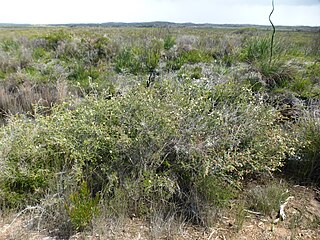
Melaleuca incana, commonly known as grey honey-myrtle, is a plant in the myrtle family, Myrtaceae and is endemic to the south-west of Western Australia and is naturalised in the south of Victoria in Australia. It is commonly grown as a garden plant and produces large numbers of white or creamy yellow flowers, sometimes highly scented, in spring.

Melaleuca incana subsp. tenella is a plant in the myrtle family Myrtaceae which is endemic to the south coast of Western Australia. It was formerly known as Melaleuca tenella Benth. but was reduced to a subspecies in 1998. It is similar to M. incana subsp. incana except in the form of the plant, the size and shape of its leaves, its flowering time and distribution.

Melaleuca oxyphylla, commonly known as pointed-leaved honey-myrtle is a plant in the myrtle family, Myrtaceae, and is endemic to the Eyre Peninsula region of South Australia. It has long, thin greyish branches, small clusters of white or cream flowers and leaves that are distinctively shaped and arranged. It is similar to Melaleuca acuminata but has longer, narrower leaves and shorter stamens.

Melaleuca stenostachya, commonly known as fibre-barked teatree or straight teatree is a plant in the myrtle family Myrtaceae and is native to the Cape York Peninsula in northern Australia, the gulf country of the Northern Territory and the south of Papua New Guinea. It is closely related to Melaleuca dealbata but can be distinguished from that species by the wide separation of the flowers in the inflorescence.
Melaleuca calcicola is a plant in the myrtle family, Myrtaceae and is endemic to the south of Western Australia. It was formerly known as a subspecies of Melaleuca apodocephala but was reassessed in 2010 and raised to species status. Its branches are corky, the leaves pointed although not prickly and the flowers are creamy white, tipped with yellow.
Melaleuca fulgens subsp. fulgens, commonly known as the scarlet honey myrtle, is a plant in the myrtle family, Myrtaceae and is endemic to the south-west of Western Australia. In 1990, the species Melaleuca fulgens was separated into 3 subspecies and this is the most widespread of them. As with the other two subspecies, this one is notable for its showy flowers which are usually red but its foliage and fruits are also attractive features.
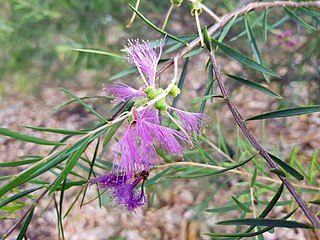
Melaleuca fulgens subsp. steedmanii, commonly known as the scarlet honey myrtle, is a plant in the myrtle family, Myrtaceae and is endemic to the south-west of Western Australia. In 1990, the species Melaleuca fulgens was separated into 3 subspecies. Of the two subspecies occurring in the south-west, this one has the narrower distribution, occurring mainly near Geraldton. As with the other subspecies, this one is notable for its showy flowers which are usually red but its foliage and fruits are also attractive features.
Melaleuca fulgens subsp. corrugata, commonly known as the wrinkled honey myrtle, is a plant in the myrtle family, Myrtaceae and is endemic to an area near the border between Western Australia, South Australia and the Northern Territory. In 1990, the species Melaleuca fulgens was separated into 3 subspecies. This subspecies has a disjunct distribution but is nevertheless very similar to the other two, only differing the colour of the flowers and small differences in the leaf shape and length of the stamens. As with the other subspecies, this one is notable for its showy flowers which are usually a shade of pink to mauve but its foliage and fruits are also attractive features.

Melaleuca salicina, commonly known as willow bottlebrush, is a plant in the myrtle family Myrtaceae, and is endemic to eastern Australia. Some Australian state herbaria continue to use the name Callistemon salignus, a name that is accepted by the Australian Plant Census. It is a shrub or small tree with soft foliage, pink new growth, white papery bark and spikes of usually white or creamy bottlebrush flowers in spring.



















